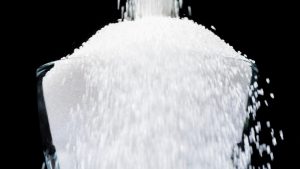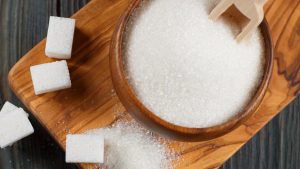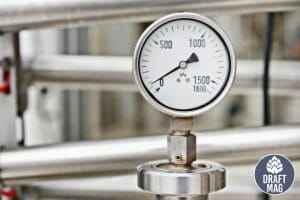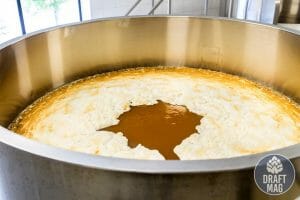Priming Sugar: A Detailed Guide Explaining the Process of Priming
 Priming sugar is the final game-changer in the beer-making process. It is the final ingredient added after the beer is fermented for carbonation.
Priming sugar is the final game-changer in the beer-making process. It is the final ingredient added after the beer is fermented for carbonation.
This can be done in a can, a bottle or a keg, and it is a common practice followed by homebrewers to use priming sugar for beer to add a lot of fizzes, which often lead to better taste and aroma.
Continue reading to discover how this process is made.
What Is Priming Sugar?
Priming sugar is any kind of sugar that restarts the fermentation process, causing the beer to bubble and froth. It is called secondary re-fermentation, and priming sugars are usually highly fermentable. It is extremely easy to carry out this process at home but the measurements need to be exact, especially when it comes to priming bottles with sugar.
The real fun in drinking beer lies in its effervescence. The bubbles that form in a glass as you pour your beer and the fizzy sound that follows until the beer settles down is what the priming sugar basically does. It creates the froth in the beer and adds that last pinch of flavor and crispiness.
Fermenting a beer is the first step in initiating beer making, but it isn’t technically called a beer yet. The bubbles are yet to be added, after which the foamy, bubbling product is what is called “beer.”
This step is done by using priming sugar. The sugar can be added in its solid form, but most homebrewers prefer to add it as a liquid just before racking the beer, or in its final container (bottle).
How To Make Priming Sugar
Priming sugars are easily available in the market, but if you wish to make it at home or by yourself, these simple steps are all you need:
- Weigh the required amount of sugar on a weighing scale. This is what you will need for the carbonation of the beer to take place.
- Boil 3/4 cups of corn sugar in two cups of water. Let it continue to boil for 3 minutes.
- Let the mixture cool. You can either leave it on the counter to cool by itself or place the pan in an ice bath for quicker cooling. When cooling the mixture, cover the pan with a lid to avoid any unnecessary things or dirt falling into it.
Voila! Your priming sugar solution is now ready to be transferred into the beer. The best way to do this is to add the priming solution to the bottom of the bucket first, then pour the fully fermented beer into the bucket.
Gently stir the entire solution with a brewer’s spoon, making sure it mixes well. Stirring it evenly is important to enable proper and even carbonation in the finished beer.
Types of Priming Sugar
Brewers across the world generally use corn sugar for priming, although cane sugar, honey, dry malt extract (DME) or other types of sugars can also be used for the process. Table sugar for priming is just another term for corn sugar.
 The most important thing when choosing which type of sugar to use is its fermentability level and the flavor it may add to the beer. Most people use corn sugar because they add almost no flavor to the beer. Corn and cane sugar are also almost 100 percent fermentable, while honey is 95 percent fermentable and DME is about 75 percent fermentable.
The most important thing when choosing which type of sugar to use is its fermentability level and the flavor it may add to the beer. Most people use corn sugar because they add almost no flavor to the beer. Corn and cane sugar are also almost 100 percent fermentable, while honey is 95 percent fermentable and DME is about 75 percent fermentable.
Sometimes, brewing kits (for homebrewers) come with priming sugar; anything else labeled priming sugar in the market is mostly just corn sugar.
This is because corn sugar leaves no added aromas or flavors behind, but cane sugar leaves an apple-cider type note in the final beer. The safest bet is to use corn sugar, but if you are keen on experimenting, feel free to use whatever you want.
Quick Overview of Different Sugars for Priming
The following table will give you a gist of the types of sugars for priming:
| Type of Sugar | Technical name | Particulars | Usage |
| Corn Sugar | Dextrose | Doesn’t impart any added flavors or aromas | Use the exact measurement as stated in your beer recipe |
| Table Sugar | Sucrose | Leaves a faint aftertaste and flavor | Use a lesser quantity of table sugar than you would corn sugar |
| Dry Malt Extract | DME | This is an unfermented wort dried into powder form. This adds flavor and body to the brew | Least used type of sugar |
Priming Sugar Substitutes: For When You Can’t Find Cane Sugar
Priming sugar substitutes aren’t advised to be used to carbonate beer, but if you absolutely need one, here are some options:
- Demerara sugar
- Agave nectar
- Honey
- Treacle
- Maple syrup
- Molasses
- Belgian candi syrup
Different Types of Priming Sugars Made for Homebrewing
There are plenty of sugars made by brewery manufacturers that you can buy to ease your process of carbonation. Buying these readily available sugars makes your job easier and reduces the risk of failure.
Some types of commercial priming sugars available in the market are:
– LD Carlson Corn Sugar
This sugar doesn’t add any color, body or flavor to the beer, but it simply quickens the carbonation process. This is 100 percent fermentable sugar.
– Ohio Priming Sugar
This brand is quite famous in the homebrewing community, and almost all products sold by them have received positive reviews. This priming sugar is excellent if you don’t want to add any flavor or color to your beer, but only increase the alcohol levels in your beer without changing the taste of the drink.
– Alternative Option
Many homebrewers use an alternative option to sugars, which is called “carbonation drops.” These are chemically manufactured drops to add extra fizz to your beer and come in tablet form. Most homebrewers prefer the natural way of carbonation, but these tablets are also an easy way to get the desired results. It’s safe to keep them as a backup.
Methods of Priming, and Which One the Experts Suggest
There are essentially two methods of priming:
– Bulk Priming
With this method, the brewer mixes a predetermined amount of priming sugar and a fully fermented beer that isn’t carbonated yet into a bottling bucket, before pouring this primed beer into different bottles. This is a preferred method used by most brewers, as it allows them to consistently prime the beer and also leaves no room for bottle bombs.
– Individual Priming
This is slightly different from batch or bulk priming. In this method, a small percentage of priming sugar is added to each bottle of fermented but not carbonated beer. The beer then gets carbonated after adding the priming sugar to it.
This is a method used by smaller beginner homebrewers who are testing and experimenting with new styles and flavors of beer. As they brew in small quantities, bottling sugar is an easier approach.
A spoon and funnel are used in this case to appropriately measure and add priming sugar to each bottle. Take note that precise measurement is needed in this method, which sometimes doesn’t happen, thereby creating different levels of carbonation in each bottle.
The brewer also needs to be careful, as a slight slip in excess sugar may lead to excess CO2 being formed, which may, in turn, make the bottle burst. You really want to avoid the mess created by a bottle bomb.
Carbonation Levels: Why It’s Important To Maintain This
Different amounts of priming sugar are used to match the different styles of beer being brewed. This means different beers are carbonated at different levels based on the final goal. Various online priming sugar calculators help in determining the apt level of CO2 for each beer.
It also calculates the amount of sugar and the type of sugar needed in the process. The volume of beer in which the desired amount of priming sugar needs to be added and the temperature of the beer can also be determined here.
The final rule of thumb after priming the beer is to store the beer in a cool, dry place away from sunlight and precisely at a temperature above 65 degrees Fahrenheit for 10 days or up to three weeks. This will make the beer carbonate properly.
Calculating Priming Sugar and Determining Perfect Carbonation
The formula is:
Residual Carbonation Level + Priming Sugar Level = Target Carbonation Level
Your bottle should not be too flat, nor can it burst out. This means you need to calculate the exact carbonation level for your beer. At the first stage of fermentation, your beer already has some level of carbonation, which is called the “residual carbonation.”
Your Target Carbonation is your final desired level of carbonation, so the math lies in determining the exact amount of priming sugar to reach your target carbonation level. To know the amount of sugar you will need, check out this sugar calculator.
Just put in your quantity, the temperature at which it was fermented, your target carbonation by volume, and the type of sugar you are using. Put this sugar quantity in your brew and finish making your drink.
A Four-step Guide To Priming Sugar and Bottling Beer
You have done everything right so far. You prepared your wort, added the yeast, and finished the fermentation. You are just two more steps away from sipping on your perfect beer.
Follow this step-by-step guide to priming and bottling your beer:
-
Prepare the Bottles
A five-gallon batch needs two cases of 12-ounce bottles. Clean them all and sanitize them thoroughly. You don’t want unnecessary reactions in your beer.
-
Clean Your Bottle Caps
Get your bottle caps ready. Sanitize them properly, as any residue may lead to a change in odor or taste of the beer.
-
Prepare Your Priming Solution
You can use readily available sugar, or you can make one yourself (from the steps above). Let the solution cool completely before using it.
-
Bottle Your Beer With a Priming Solution
Make sure this process is done slowly and with the utmost care. Use a brewing spoon and a funnel, as you cannot allow the solution to splash. If too much air goes into the mixture, the oxygen might ruin the taste of the brew.
You don’t need to stir the solution either. When you pour beer into the priming solution, it automatically mixes well. You must stir or swirl the mixture only if you are following bulk priming.
Frequently Asked Questions
So, you have read the entire guide to priming sugar and are now ready to try the process yourself. But wait, you still have some more queries that are left unanswered.
Not to worry, these are the answers to some priming sugar FAQs:
Is Priming Sugar Important? Can This Step Be Skipped?
It is an important step. You must not skip it. Sugar is like food to yeast, and this is responsible for the fizz you get in a beer.
What is beer without the fizz, right?
Can Regular Sugar Be Used as a Substitute?
Yes. You can use white sugar and brown sugar too. It is all about experimenting.
Should Priming Sugar Be Added Before the Beer or After in Bottles?
Experts recommend adding the priming sugar before bottling. It is easier to maintain the quality and the chances of the liquid splashing are reduced.
Why Is It Best To Avoid Oxygen for Home Brewing?
Oxygen is good, before fermentation. It is a contaminant once fermentation has begun. Any amount of oxygen can make your beer stale and spoil its flavor and clarity.
Oxygen can also enter the brew when transferring the beer from one container to another, so this is why brewers suggest keeping the final brew away in a dark spot, untouched for days.
Does Priming Sugar Go Bad?
With time, priming sugar may change in texture, but the taste, not so much.
Conclusion
 Here are the most important points we discussed in this article about priming sugars.
Here are the most important points we discussed in this article about priming sugars.
- Priming sugar is the final most important ingredient in the beer-making process.
- It is the deciding factor of the fizz levels in your beer.
- The sugar must be added in a liquid form.
- Homebrewing can be fun if the recipes are followed precisely, and trying and testing is the best way to learn what suits your style the best.
- When it comes to priming sugar for beers, it is important to understand the carbonation levels, the right measurement of sugar, and pick the right technique of priming.
- Being informed on what to expect and practice makes the process easier.
Now that you know how the priming process works for beers, you can now be more confident in your homebrewing skills. Go out there and make the best beer ever!






